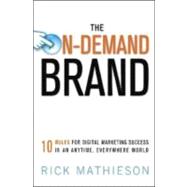
Note: Supplemental materials are not guaranteed with Rental or Used book purchases.
Purchase Benefits
What is included with this book?
RICK MATHIESON (San Francisco, Calif.) is a leading voice on marketing in the digital age. Harvard Business School’s Working Knowledge calls him “a strategic marketing expert.” His insights have been featured in ADWEEK, Advertising Age, Wired, Broadcasting & Cable and on MSNBC, CBS Radio and NPR. A regularly featured speaker at industry events, Mathieson also serves as vice president and creative director for Creative i Advertising & Interactive Media, and is the author of Branding Unbound.
| Introduction | p. ix |
| Insight Comes Before Inspiration | p. 1 |
| Q&A: The Klauberg Manifesto | p. 21 |
| Don't Repurpose, Reimagine | p. 31 |
| Q&A: Alex Bogusky Tells All | p. 51 |
| Don't Just Join the Conversation-Spark It | p. 59 |
| Q&A: Virtually Amazing: Sibley Verbeck on Building Brands in Second Life 2.0 | p. 81 |
| There's No Business Without Show Business | p. 89 |
| Q&A: Adrian Si: Rewriting the Rules of Branded Entertainment | p. 107 |
| Want Control? Give It Away | p. 113 |
| Q&A: "Obama Girl" Makes Good: Ben Relles's Racy Videos and the Democratization of Digital Media | p. 127 |
| It's Good to Play Games with Your Customers | p. 135 |
| Q&A: Mike Benson and the ABCs of Advergames | p. 151 |
| Products Are the New Services | p. 157 |
| Q&A: Agent Provocateur: Goodby's Derek Robson on Reinventing the Ad Agency | p. 169 |
| Mobile is Where It's At | p. 179 |
| Q&A: BMW and Beyond: "Activating" Traditional Media through the Power of Mobile | p. 199 |
| Always Keep Surprises In-Store | p. 207 |
| Q&A: The Future of the In-Store Experience, from the Father of Social Retailing“ | p. 221 |
| Use Smart Ads Wisely | p. 231 |
| Q&A: The Social Net-Privacy 2.0 | p. 251 |
| Additional Resources | p. 261 |
| Notes | p. 263 |
| Acknowledgments | p. 273 |
| Index | p. 275 |
| About the Author | p. 281 |
| Table of Contents provided by Ingram. All Rights Reserved. |
The New copy of this book will include any supplemental materials advertised. Please check the title of the book to determine if it should include any access cards, study guides, lab manuals, CDs, etc.
The Used, Rental and eBook copies of this book are not guaranteed to include any supplemental materials. Typically, only the book itself is included. This is true even if the title states it includes any access cards, study guides, lab manuals, CDs, etc.